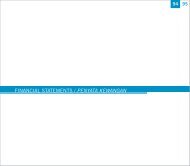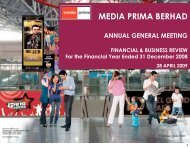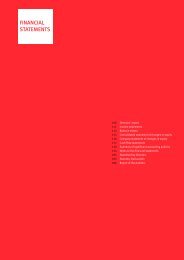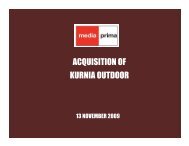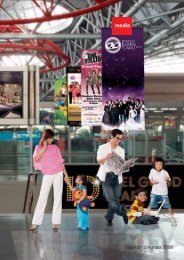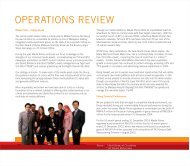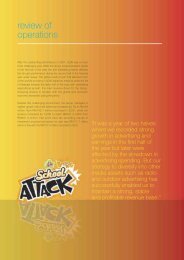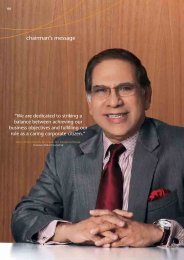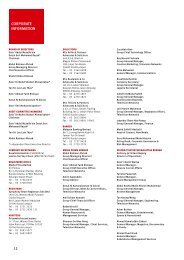2012 Annual Report - Media Prima Berhad
2012 Annual Report - Media Prima Berhad
2012 Annual Report - Media Prima Berhad
You also want an ePaper? Increase the reach of your titles
YUMPU automatically turns print PDFs into web optimized ePapers that Google loves.
<strong>Media</strong> <strong>Prima</strong> <strong>Berhad</strong><br />
Commitment<br />
to the Environment<br />
MATERIALS MANAGEMENT<br />
In <strong>2012</strong>, the NSTP introduced an ink optimising programme<br />
to promote the most efficient ink usage. Software was<br />
introduced in the digital pages to convert composite black<br />
pixels made from cyan, magenta, yellow and black to 95%<br />
black. This has resulted in 2.5% savings in pages per kg.<br />
In addition to the overall reduction in colour ink<br />
consumption, the software also improves the quality of<br />
reproduction due to less ink being deposited onto the<br />
paper. This produces a clearer look and an enhanced<br />
“perceived” brightness of printed pictures.<br />
In <strong>2012</strong>, NSTP continued to reduce its waste by changing<br />
Computer to Film (CTF) to Computer to Plate (CTP) and<br />
phased out the usage of films. During 2011, CTF was<br />
phased out at our Shah Alam Plant. In <strong>2012</strong>, we rolled this<br />
initiative out at our plants in Prai, Senai and Ajil. This<br />
process reduces chemical waste as the developments of<br />
films are no longer required. The usage of traditional<br />
photographic films, which was a major cost to us, has been<br />
phased out. The CTP also helps to shorten our process flow,<br />
reduces overall processing time and eliminates traditional<br />
film chemistry which was previously one of the dirtiest<br />
waste generators. It also enhances the effect of ink-saver<br />
software due to greater digital control at the<br />
plate-making stage.<br />
During the year, NSTP engaged a specialist to conduct roller<br />
maintenance at our plants in Prai and Shah Alam. This has<br />
led to lower run-up wastage and a reduction in the overall<br />
consumption of newsprint, inks and other production<br />
materials.<br />
Materials usage at NSTP Printing Plants<br />
Material (MT) 2010 2011 <strong>2012</strong><br />
Newsprint 92,003 85,058 87,335<br />
Ink 1,951 1,736 1,739<br />
Our press system upgrade continues to improve in-house<br />
efficiency by reducing start up copies and printing<br />
registrations. These initiatives are ongoing and have further<br />
reduced newsprint wastage and paper consumption in terms<br />
of pages per kg.<br />
We are revamping our newsprint management strategy to<br />
shorten logistics, eliminate unnecessary handling and reduce<br />
overall inventory levels. In order to achieve this, our aim is<br />
to ensure each plant has its own warehouse of adequate<br />
capacity to accomodate Just-In-Time (JIT) deliveries. The<br />
implementation of the JIT principle has saved time and<br />
waste by reducing the warehouse process from our logistics.<br />
This strategy was introduced at our Balai Berita Prai in <strong>2012</strong>.<br />
We hope to repeat this for Balai Berita Shah Alam in 2013<br />
to benefit from the same JIT principle. This is in collaboration<br />
with Malaysian Newsprint Industries (MNI).<br />
Chemical usage, Pre-Press (litres) at NSTP Printing Plants<br />
Chemicals<br />
(Pre-Press,<br />
Main)<br />
Shah<br />
Alam Prai Senai Ajil Total<br />
2010 11,800 12,670 12,760 10,555 45,735<br />
2011 11,565* 12,480 11,095 8,940 49,360<br />
<strong>2012</strong> 10,720 9,570 9,450 9,135 38,875<br />
* higher consumption due to testing of Anocoil plates<br />
WATER MANAGEMENT<br />
Our printing presses adopt a closed system for the press<br />
in which a spray bar is being used. The spraybar system,<br />
or “pulsed dampening system”, generates a fine mist of<br />
fountain solution (water treated with 2% surfactants) to<br />
provide dampening on the printing plates. Compared to<br />
conventional or older spray bar technologies, the system in<br />
use allows for minimal water consumption due to a higher<br />
ratio of dispersed area against amount of water used. We<br />
have modified the system to deactivate the recirculation of<br />
excess fountain solution. This eliminates contaminants from<br />
returning to the main holding tanks. It also ensures that the<br />
spray bar nozzles operate at maximum efficiency as oil,<br />
grease and ink droplets are eliminated from the whole<br />
system.<br />
80<br />
annual<br />
report<br />
<strong>2012</strong><br />
In <strong>2012</strong>, three workshops were held to promote the sharing<br />
of best practices in the workplace. The practice of sharing<br />
information aims to improve productivity and efficiency<br />
in each plant. Daily production reports are published for<br />
each of the plants along with a company average. This<br />
process introduced an element of competition which led to<br />
further improvements.




